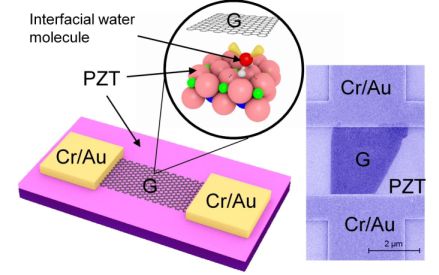Graphene is a two-dimensional material that consists of carbon atoms arranged in a hexagonal lattice. Graphene has a very high electronic conductivity that could be tuned by external electric field. Ferroelectrics comprise an important group of materials, which possess a permanent electric polarization. When graphene and a ferroelectric material are combined in a hybrid ferroelectric/graphene heterostructure, the polarization of a ferroelectric could be used to tune the conductivity of graphene. MRSEC researchers have grown graphene on ferroelectric Pb(Zr0.2Ti0.8)O3 (PZT) films and showed that ferroelectric polarization switching leads to a significant change in the conductivity of graphene. They found that the critical role in the performance of these hybrid devices is played by water molecules adsorbed at the interface between graphene and a PZT film. An accurate chemical control of the molecular water layer at the interface improves ferroelectric polarization stability and its effect on the conductivity of graphene. This study demonstrates a functional field-effect transistor with a capability of non-volatile performance, which makes such a device promising for applications in data storage and computer logics.

Schematic (left) and scanning electron microscopy image (right) of a graphene (G) field-effect transistor with gold (Au) electrodes fabricated on a ferroelectric Pb(Zr0.2Ti0.8)O3 (PZT) substrate. The inset shows a water molecule at the interface between graphene and PZT.